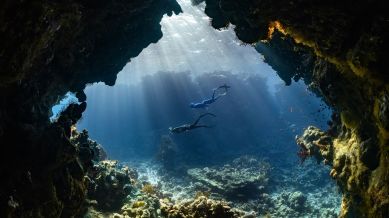Spitsbergen discovery: Over 30k fossils found in dinosaur-era sea reptile habitat on Arctic island
The findings in Spitsbergen demonstrate that marine ecosystems rebounded rapidly after the end-Permian mass extinction, challenging the idea that recovery was slow.

A fossil discovery on the Arctic island of Spitsbergen in the Svalbard archipelago has revealed the earliest known sea reptile habitat from the age of dinosaurs. More than 30,000 fossils, including teeth, bones, and coprolites (fossilised faeces), have been discovered, representing a vast range of marine reptiles, amphibians, bony fish, and sharks that lived about 249 million years ago.
This amazing finding provides a unique window into an ancient ocean environment and revolutionary insights into how marine life regenerated and diversified so quickly following the end-Permian mass extinction, the most catastrophic die-off in Earth’s history.
Marine food systems’ reconstruction over 3 million years
Although the fossils were first discovered in 2015, it took over 10 years of painstaking excavation, preparation, and examination to properly comprehend their significance. The work was done by a group of Scandinavian palaeontologists from the Swedish Museum of Natural History in Stockholm and the Natural History Museum at the University of Oslo. According to a study published in Science, their results demonstrate that marine life recovered quickly from the end-Permian mass extinction, creating intricate feeding chains only 3 million years after this disastrous occurrence.
A glimpse of a vibrant ecology is captured by the Spitsbergen fossil bed, which is so dense that it creates a noticeable bonebed along the mountainside. Various fossils can be found, from small fish scales and shark teeth to massive marine reptile bones, such as those of ichthyosaurs, which range in length from less than one metre, to apex predators more than five metres.
After mass extinction, fossils show signs of early recovery in marine life
Palaeontologists once thought that it took about 8 million years for marine ecosystems to recover from the end-Permian extinction, also known as the “Great Dying”, which wiped out over 90 per cent of marine species. Given that a variety of marine reptiles and amphibians are now flourishing in open-ocean environments, the Spitsbergen fossils point to a considerably quicker rebound.
Aphaneramma, a marine amphibian that hunts bony fish; Cymbospondylus, a massive ichthyosaur that lurks in the deep as an apex predator; and Grippia longirostris, a small ichthyopterygian that feeds on squid-like ammonoids, were among the creatures discovered.
These fossils indicate that the diversification of sea-going reptiles may have begun earlier than previously thought, possibly even before the end-Permian extinction.
Discovery illuminates beginnings of contemporary marine communities
The Spitsbergen discovery is significant because it reveals an astonishingly rich diversity of marine vertebrates from the dawn of the age of dinosaurs, showing that complex food webs were established much earlier than previously thought. It also demonstrates that marine ecosystems rebounded rapidly after the end-Permian mass extinction, challenging the idea that recovery was slow.
The fossils provide valuable evolutionary insights, illustrating how land-living animals adapted to offshore habitats, from small hunters to giant apex predators, and highlight how this early ecosystem reset laid the foundations for modern marine communities.
Fossil excavation over 36 sq m using 1 sq m grids resulted in the collection of over 800 kg of material, encompassing small fish scales to large reptile bones. Each specimen was meticulously recorded, enabling scientists to reconstruct the ancient ocean’s food chain and community structure, revealing detailed predator-prey dynamics and the ecological niches that existed.
The findings indicate a rapid recovery of marine ecosystems following the end-Permian mass extinction, highlighting diverse aquatic reptiles such as ichthyosaurs and marine amphibians. This study challenges previous beliefs about the gradual regeneration of ecosystems post-catastrophe, illustrating the resilience of life in the face of extinction events.